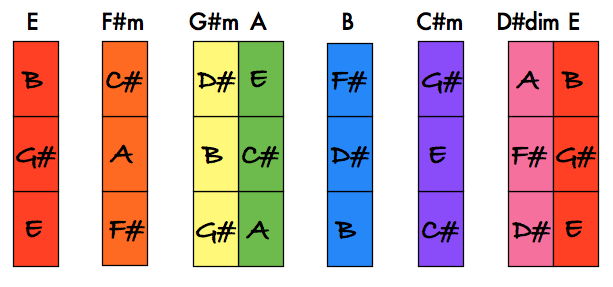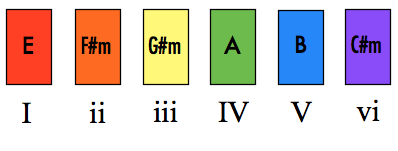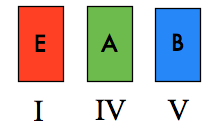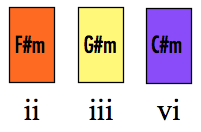How to play "If I Die Young" on the piano
/One of the most beautiful newer songs I've heard lately is "If I Die Young" by The Band Perry, written by Kimberly Perry. The sentiment ("I'm at peace with death because I trust that I've lived well in the time I've been given") guarantees that this will be a funeral tearjerker for years to come.
Best of all, "If I Die Young" is a very simple song to play - and I'll help you figure out how!
Yes, I'll help you figure it out. There are resources online that might show you exactly how to play "If I Die Young", but I'll give you tools you can use on other songs.
If you just want to learn this song in the simplest way possible, scroll all the way down to the bottom of this post.
But if you've ever wondered how the people who make videos and tutorials learn to play the songs in the first place, you can dig a little deeper.
This is a fifty-dollar piano lesson disguised as a blog post! Read and learn.
Finding the Key
The key is the tonal center of the song. In other words, the note that feels like "home." The note that the key is named after is called the tonic. When you play the tonic, it will feel grounded and settled, like the song could end right there.
Put on the recording of "If I Die Young" and play the C below middle C on the piano. That's definitely not it! It clashes. Move up in half-steps (don't forget the black keys!) until you find the tonic.
Did you get it? It's E. Other notes that would have sounded pretty good are C#, A, B, and a few others, so don't feel bad if you were convinced it was something else. Soooo: "If I Die Young" by The Band Perry is in the key of E!
Ummm...how is that helpful?
The Scale
Once we have the key, we can figure out the scale. If you take all of the notes that belong in the key of E and put them in order from lowest to highest, you have the scale. The melody (tune) and harmony (chords) of the song come from that scale.
The E major scale is this:

I'll save the why for another day. However, I will point out that between E and F# there is a whole step, which is why they are spaced apart above. Between G# and A is a half-step. What is the interval between B and C#? I you said "a whole step," you are correct! And between D# and E? Yes, a half-step. All major scales follow the pattern you see above.
So, the melody of the song will use the seven different notes in the E major scale. Cool, huh? Now, how do we figure out what the chords are?
Finding the Chords
You get the first chord by picking out the first, third, and fifth degrees of the scale, like so:
 The notes in the E chord are E, G#, and B!
The notes in the E chord are E, G#, and B!
Here's the next chord:
 This chord is F-sharp minor (F#m): F#, A, and C#). Why F-sharp minor? The chord you build on the second degree of the scale is always minor. We'll talk more about that in a minute, and maybe another day I'll tell you what makes the chord itself minor.
This chord is F-sharp minor (F#m): F#, A, and C#). Why F-sharp minor? The chord you build on the second degree of the scale is always minor. We'll talk more about that in a minute, and maybe another day I'll tell you what makes the chord itself minor.
Can you guess what the notes in the next chord are going to be?
 Yes, they are G#, B, and D# - a G#m chord!
Yes, they are G#, B, and D# - a G#m chord!
Take a minute and build chords on A, B, C#, and D# - I'll wait here. Remember that there are two Es, so you'll only count E once as you're doing your skipping.
Done? Okay, you should have gotten:
A: A C# E
B: B D# F#
C#m: C# E G#
D#dim: D# F# A
Good job! Here they are, all together:
 Maybe I just felt like getting a little rainbowy, okay?
Maybe I just felt like getting a little rainbowy, okay?
Now...here's the cool part. The chords themselves form a pattern that is consistent in any major key.
Diatonic Chords
Diatonic chords are chords that belong in the key. You can borrow chords from other keys to add a little spice - after all, not every song has just six chords. Here are the names for the diatonic chords:

Quite imaginative names, huh? But at least they're easy to remember. The chord built on the first note of any major scale is I (one). The chord built on the fifth note of any scale is V (five).
At this point, let's simplify:

The seven is like the end of the onion - we'll just throw it out. We pretty much never use that diminished chord in popular styles.
Now we've got three major chords:

And three minor chords:

The cool thing about these numbers is that they'll allow you to just listen to a recording and be able to tell what the number is of the chord you're hearing.
Finally Figuring Out the Actual Song
Okay! So. Now comes the easy part, based on all this knowledge.
By feel, you can figure out where the chords change. Through trial and error (if you're inexperienced) or based on the sounds of the chords (if you have a more developed ear), you can figure out which of these six chords we're using, and what order they go in. If you really want to improve your musicianship, spend some time doing this before you scroll down to get the "answer."
Here is the basic chord pattern:

The diagonal slashes represent the beats, while the vertical line separates the measures (i.e., groups of beats). Basically, each chord lasts for two beats.
Depending on your experience, you can play the chords very simply or do a more complex groove. I recommend playing along with the recording to get the feel.
That is pretty much the whole song! Yes, you could have probably gotten it using trial and error if you have a lot of experience doing that. But here, you learned why these chords go together, and where they come from. That will help you learn your next hundred songs, and maybe even write a few.
Which song do you want to learn next?
